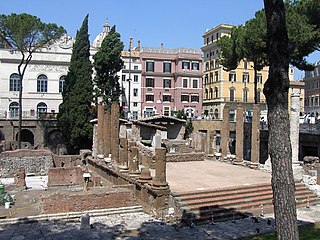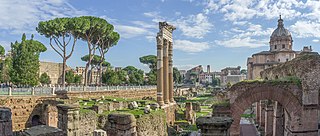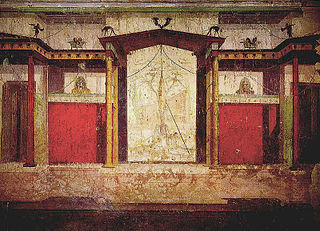
The Roman Forum, also known by its Latin name Forum Romanum, is a rectangular forum (plaza) surrounded by the ruins of several important ancient government buildings at the centre of the city of Rome. Citizens of the ancient city referred to this space, originally a marketplace, as the Forum Magnum, or simply the Forum.
Quintus Lutatius Catulus was a consul of the Roman Republic in 102 BC. His consular colleague was Gaius Marius. During their consulship the Cimbri and Teutones marched south again and threatened the Republic. While Marius marched against the Teutones in Gaul, Catulus had to keep the Cimbri from invading Italy. In this he failed; the Cimbri succeeded in invading the Po Valley. In 101 BC Catulus, as proconsul, continued the war against the Cimbri. Marius, elected consul for the fifth time, joined him and together they campaigned against the Germanic invaders in the Po Valley. At the Battle of Vercellae Marius and Catulus decisively defeated the Cimbri and ended the Germanic invasion. After Vercellae the two feuded, and Catulus consequently committed suicide following Marius's victory in the civil war of 87 BC.

Festivals in ancient Rome were a very important part in Roman religious life during both the Republican and Imperial eras, and one of the primary features of the Roman calendar. Feriae were either public (publicae) or private (privatae). State holidays were celebrated by the Roman people and received public funding. Games (ludi), such as the Ludi Apollinares, were not technically feriae, but the days on which they were celebrated were dies festi, holidays in the modern sense of days off work. Although feriae were paid for by the state, ludi were often funded by wealthy individuals. Feriae privatae were holidays celebrated in honor of private individuals or by families. This article deals only with public holidays, including rites celebrated by the state priests of Rome at temples, as well as celebrations by neighborhoods, families, and friends held simultaneously throughout Rome.

The Campus Martius was a publicly owned area of ancient Rome about 2 square kilometres in extent. In the Middle Ages, it was the most populous area of Rome. The IV rione of Rome, Campo Marzio, which covers a smaller section of the original area, bears the same name.

Gaius Lutatius Catulus was a Roman statesman and naval commander in the First Punic War. He was born a member of the plebeian gens Lutatius. His cognomen "Catulus" means "puppy". There are no historical records of his life prior to consulship, but his career probably followed the standard cursus honorum, beginning with service in the cavalry and continuing with the positions of military tribune and quaestor.

The Temple of Jupiter Optimus Maximus, also known as the Temple of Jupiter Capitolinus, was the most important temple in Ancient Rome, located on the Capitoline Hill. It was surrounded by the Area Capitolina, a precinct where numerous shrines, altars, statues and victory trophies were displayed.

The Theatre of Pompey, also known by other names, was a structure in Ancient Rome built during the latter part of the Roman Republican era by Pompey the Great. Completed in 55 BC, it was the first permanent theatre to be built in Rome. Its ruins are located at Largo di Torre Argentina.

The Porticus Octaviae is an ancient structure in Rome. The colonnaded walks of the portico enclosed the Temples of Juno Regina (north) and Jupiter Stator (south), as well as a library. The structure was used as a fish market from the medieval period up to the end of the 19th century.

The Forum of Caesar, also known by the Latin Forum Iulium or Forum Julium, Forum Caesaris, was a forum built by Julius Caesar near the Forum Romanum in Rome in 46 BC.

The Arch of Augustus was the triumphal arch of Augustus, located in the Roman Forum. It spanned the Via Sacra, between the Temple of Castor and Pollux and the Temple of Caesar, near the Temple of Vesta, closing off the eastern end of the Forum. It can be regarded as the first permanent three-bayed arch ever built in Rome.

The gens Lutatia, occasionally written Luctatia, was a plebeian family of ancient Rome. The first of the gens to obtain the consulship was Gaius Lutatius Catulus in 242 BC, the final year of the First Punic War. Orosius mentions their burial place, the sepulchrum Lutatiorum, which lay beyond the Tiber.
Quintus Lutatius Catulus Capitolinus was a politician in the late Roman Republic. His father was the like-named Quintus Lutatius Catulus, consul in 102 BC. He gained the agnomen "Capitolinus" for his defense of the capital in 77 BC against Lepidus.

The House of Augustus, or the Domus Augusti, is situated on the Palatine Hill in Rome, Italy. This house has been identified as the primary place of residence for the emperor Augustus.
The Porticus Catuli was a portico on the Palatine Hill in ancient Rome. It was a local landmark. It was built by Quintus Lutatius Catulus to commemorate his joint victory with Gaius Marius over the Cimbri at Vercellae.

The Curia of Pompey, sometimes referred to as the Curia Pompeia, was one of several named meeting halls from Republican Rome of historic significance. A curia was a designated structure for meetings of the senate. The Curia of Pompey was located at the entrance to the Theater of Pompey.

Fortuna Huiusce Diei was an aspect of the goddess Fortuna, known primarily for her temple in the Area Sacra di Largo Argentina at Rome. Cicero lists her among the deities who should be cultivated in his ideal state, because "she empowers each day". She thus embodies an important aspect of time as it figures in Roman religion: every day of the year had a distinct and potent nature, which the public priests were responsible for knowing and aligning the community with by means of the religious calendar.

The Torre Argentina Cat Sanctuary is a cat shelter in Rome, Italy, that makes use of the ancient ruins of Largo di Torre Argentina by providing a home within them for around 150 cats.
The Atrium Libertatis was a monument of ancient Rome, the seat of the censors' archive, located on the saddle that connected the Capitolium to the Quirinal Hill, a short distance from the Roman Forum.

The Regio IX Circus Flaminius is the ninth regio of imperial Rome, under Augustus's administrative reform. Regio IX took its name from the racecourse located in the southern end of the Campus Martius, close to Tiber Island.





















